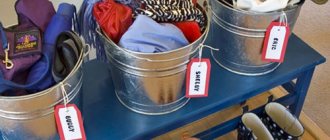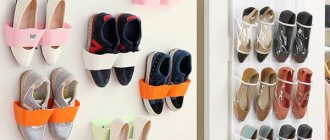With the arrival of colder weather, it’s time to put summer clothes into long-term storage. Anything temporarily unnecessary can be thrown into a suitcase, stacked on the balcony, or even left collecting dust in the closet. However, experts recommend conducting a seasonal audit of things and carefully removing what will not be useful in the coming months. Moscow 24 found out how to properly store clothes and shoes from your summer wardrobe so that they don’t take up much space and last longer.
Photo: depositphotos/belchonock
Shoe preparation and storage rules
In some cases, the issue of shoe distribution concerns seasonal products that will not be needed for at least a month or two. And if summer slates and sandals are easier to hide, due to their relative compactness, then winter boots will require much more space and better organization of space.
Before putting away your shoes, it is important to properly prepare them for seasonal storage so that they last for many years and maintain their appearance:
- Only clean shoes can be stored. Before placing a pair of shoes or boots in a “long box”, it is worth washing the soles from dust and dirt, walking over the surface with a cloth or sponge, then wiping them dry. Dirty shoes are not stored because it is unhygienic, inconvenient and destructive to the surface (dirt and sand may contain reagents used to treat roads).
- To prevent creases, abrasions and deformation, boots should be tightly stuffed with paper, cloth or polyethylene. Plastic or foam molds and pads are also suitable.
- Pairs made from natural materials must be treated with special care compounds to prevent cracking.
- If the shoes have been damaged, it is better to have them restored or sent to a workshop before sending them for seasonal storage. It is advisable to throw out worn-out shoes and boots altogether - why keep unnecessary and long-outdated items at home?!
- Divide pairs by season, accessories (men's, children's, women's), frequency of use.
Insects
The ubiquitous moth butterflies are a classic of the genre. Do you think moths will disdain shoes? You are wrong! This clothing locust is extremely democratic when choosing “dishes”. Natural fur on shoes, if there are also traces of sweat on it, is a wonderful delicacy. Also, a small detail: shoe boxes always (should have!) holes for ventilation. And if you leave fur shoes without proper attention, moths, alas, will definitely get there. The times of total shortages are long behind us, but in order to avoid not very pleasant incidents, we recommend treating shoes with fur trim with a special compound or anti-moth spray. Additionally, tablets, briquettes, plates, cedar balls or sachets and other repellents can be placed in shoe boxes or plastic containers.
To summarize, we can note the simplicity and accessibility of the rules considered: compliance with them does not require any difficulty or serious material costs for owners, and the result will be favorite shoes that can last for a long, long time.
Storage in original boxes
The most obvious option is to put the shoes in the cardboard boxes in which they were brought from the store. By the way, many people do this, and as a result, you inadvertently find a bunch of boxes of different colors in the closet, dressing room or on the mezzanine. This method has a right to exist; storing winter shoes often works out this way.
Advantages:
- store boxes - a ready-made storage option suitable for the size of a specific pair;
- protection from dust, moisture, external environmental factors;
- free – no need to spend money on cases and organizers;
- relatively compact.
About the disadvantages:
- visual noise. Boxes of different colors, shapes and sizes create a feeling of disorder and attract unnecessary attention. On open shelves and racks, piles of boxes look sloppy; the best option is to organize storage in a closet;
- different sizes and dimensions create difficulties with placement. You will have to play with spatial thinking in order to store all the boxes in one area as compactly as possible.
Proper shoe care
Proper storage always begins with proper care, which is based on cleanliness and ventilation. Clean shoes are preserved much better, so adhere to the following rules:
- Remove dirt and dust from your boots after each use.
- After cleaning, treat leather shoes with cream, and suede shoes with special water-repellent sprays.
- Dry wet shoes naturally; in extreme cases, use a special drying device or make a dryer yourself.
- Dry the insoles separately if they are removed.
Important! Leather or suede shoes deteriorate from high temperatures.
- After cleaning and treatment, air out boots and shoes.
Important! The entire care package will not take much time if you get the hang of it and act clearly step by step. In this case, when the time comes to put away your winter shoes for the summer, you will not have any problems with preparing the products.
Organizers, storage systems
There are a lot of goods and useful little things for the home on sale; you can buy them in almost any supermarket. Cute similar organizers for storing pairs of shoes are a godsend for perfectionists. Open boxes, fabric folding cases, mesh organizers with locks in the same style - convenience and beauty in “one bottle”.
Their advantages:
- visual harmony, sense of order;
- ease of storage;
- speed of identification (such organizers have special transparent windows or labels for marking).
Flaws:
- additional expenses;
- small sizes. Typically, summer or small-sized shoes are stored in organizers. But it’s already difficult to place high boots there.
Advice! If you don’t want to spend money on beautiful rag or cardboard organizers, you can use a worthy alternative - transparent plastic open or closed containers. The only caveat is to ensure proper ventilation by making holes for air exchange inside the container.
General cleaning
It is not enough to simply wipe your shoes with a cloth and put them in the closet. There are 5-7 long months of heat and active insect life ahead. To prevent your favorite boots from deteriorating during this period, you must first clean them well.
Dirt on boots and traces of sweat on insulation are food for bacteria and fungus. In addition, “odorous” pollution attracts insects.
Therefore, you need to carefully clean your favorite pair before storing:
- It is necessary to wash the inside of the boots. To do this, use liquid detergents for wool. They rinse well and do not clog the material like powders and soaps.
- The insole should be properly removed before the procedure. It is replaced with a new one or washed separately.
- The detergent is diluted according to the instructions. The temperature of the soap solution should not exceed 30 degrees.
- Next, the solution is poured into the shoes and left for 5 minutes.
- They go through the inside of the boots with a brush.
- Rinse with clean water and dry.
- The outside of the shoes is cleaned with soft brushes, and suede and nubuck are cleaned with special cleaning foam.
Winter shoes, especially leather and suede, should not be in contact with water for too long. You need to wash them in 15-30 minutes.
Advice. If the inside of the boots is relatively clean, you can not wash them inside, but vacuum them and treat them with an antiseptic shoe spray.
How to store shoes without boxes?
It happens that the packaging is lost, thrown away, deformed or missing altogether (usually shoes in non-specialized chain stores are sold without boxes). In such a case, there are several options for placing unused pairs.
Shelves in the closet
The storage system helps to rationally use wardrobe space. Shoes in the closet can be stored in special shoe compartments and on shelves, as well as in metal mesh baskets - you just have to decide what is best for a particular case.
Shoe shelves located in the closet are:
- stationary - ordinary products made from furniture panels, on which it is convenient to place various objects, incl. shoes;
- retractable - shelves with movable fittings, allowing you to easily reach hard-to-reach places and get what you need from the depths of the cabinet. Save space and easy to use;
- folding - these can often be found in shoe racks or special compartments for shoes in a prefabricated storage system. They run smoothly and are very comfortable.
Railings and slats in the closet
An interesting and quite popular way to store things and shoes is a railing system and slats. This solution saves space inside, while allowing you to place a fairly large volume of cabinet contents. Typically, roof rails are installed in compartments for outerwear and things on hangers, but shoes can also be stored on tubes by hanging them on special hangers or placing them on two adjacent tubes.
Shelves in the dressing room
If the space allows you to have your own dressing room, and there are a lot of shoes, then beautifully arranging shoes on shelves in a magazine style is one of the right solutions to the storage issue.
This room can have both open and closed shelving, but open shelving is best for storing shoes or footwear in good condition. In closed ones you can hide everything that is not so attractive to the eye, but provided that the doors are not made of transparent glass.
On hangers
An interesting option for storing high boots and shoes with elastic tops is to hang them on hangers with rubberized clips. This fastening does not deform the shoe material, the boots can be placed compactly, and the method itself is quite extraordinary.
On special spacers
Such devices can be purchased as an option when purchasing a wardrobe system or sold separately. The idea is to put each pair on special spacers, which can be retractable or static. Shoes are convenient to take off and put back in place; they do not deform during storage and are less prone to creases.
Advice! You can make a rack with spacers for boots yourself at home, using improvised means or ordinary PVC pipes with fasteners.
In the shoe store
A good option for storing frequently used pairs of shoes is a special cabinet - a shoe rack. The drawers and doors are designed in such a way that when opened, shelves with shoes slide out. Such furniture allows you to conveniently arrange all pairs, easily find them and remove them if necessary.
Shoe racks, due to their depth and width, take up little space, which allows them to be placed even in a small hallway.
Advice! Shoe racks with mirrored doors will allow you to neatly place all your seasonal shoes in the hallway and save on the purchase of a mirror.
Anti-deformation
Proper preparation of winter shoes for storage includes the use of shoe lasts. They come in plastic and foam. In general, the material is not very important. If there are no special lasts, you can stuff your shoes with newspapers or office paper. The main thing is that they are not stored flattened.
It is recommended to insert inserts into the tops of boots:
How to store shoes if there is little space?
A small living space requires proper organization of storage and maximum use of scarce square meters. It is quite difficult to arrange all the things in a limited area, so non-standard solutions are used.
Under the bed
Usually the under-bed space is not used at all, the maximum is drawers for linen. But if there is catastrophically little space, any solutions are useful:
- for example, for a small apartment, fairly high beds with a lifting mechanism are purchased, inside of which you can store seasonal items and boxes of small items;
- An alternative option is to store out-of-season shoes under a regular bed with legs in cardboard boxes, drawers, organizers, and plastic containers. In this case, getting to the desired pair will be more difficult than with a lifting mechanism or roll-out boxes. But the boxes that spoil the appearance are safely hidden from view.
Under the stairs
If you are the owner of a home with several floors, then to save space you can adapt the openings under the stairs for storage systems. You can equip the space with shelves, racks, or simply stack boxes on top of each other. The main thing is that everything fits.
In the back room
Utility rooms and storage rooms often become places where seasonal and unused items accumulate. It is logical to organize shoe storage in the utility room, but first you should carry out an audit and get rid of unnecessary things. Placement options: boxes, drawers, organizers, baskets, shelves and even a railing system.
On hanging shelves
Often, in order not to clutter up the already scarce space with furniture, hanging wall shelves are used to organize storage areas. Often this solution is found in narrow corridors and small hallways.
With this method, it is recommended to additionally pack shoes to protect them from moisture, dust and sunlight. You can store pairs nicely and compactly in identical cases or boxes, and shoes without packaging should be stored in dust bags.
Is it possible to store shoes on the balcony?
This question comes up quite often, since in small Russian apartments the balcony is one of the most popular places for storing seasonal items.
Yes, this option for placing winter shoes in the summer is possible subject to certain conditions:
- the balcony is glazed and insulated - this minimizes the likelihood of damage to things by dampness, dust and sunlight;
- shoes are stored in closed but ventilated containers or canvas bags, away from sunlight;
- pairs are prepared for the off-season and are filled with material inside to avoid deformation.
It is strictly not recommended to store any shoes on the balcony in winter - the products will inevitably be destroyed by temperature changes, excess humidity, and freezing of residual moisture in the pores of the material.
The exception is insulated heated balconies, where the temperature regime is +15 to +25°C.
Complete drying
After general cleaning, the shoes should be dried thoroughly, preferably with an electric dryer. The sole must also be dry and clean.
We recommend: How to freeze spinach for the winter - benefits all winter long
Before summer storage, shoes are dried for at least 8 hours in a dryer and another 24 hours in a ventilated room. People often rush to pack their winter boots. Such a mistake is fraught with the appearance of an unpleasant smell of dampness and mold. It should be taken into account that the last thing to dry is not the insulation, but the area between the sole and the insole. You cannot judge the dryness of boots by appearance or even by touch. Droplets of moisture may remain inside. It’s better to play it safe and let your shoes dry for an extra day.
Advice. If you plan to store your winter boots in a damp place (which is not recommended), put 2-3 packets of silica gel inside.
You can replace the silica gel with socks filled with coarse rock salt or plain rice.
Storing shoes made from various materials
It is important to understand that the durability of shoes largely depends on both its quality and proper use and further storage. Different materials require special treatment and care, so long-term storage conditions may vary.
Leather
Leather shoes are beautiful, comfortable and durable, but they are finicky and require special care and must be moisturized to prevent them from drying out and cracking. Before storing shoes made of genuine leather:
- Wash your boots from street dirt and dust and dry them.
- Use filler or shoe lasts to prevent deformation. It is better to hang boots with high tops, but do not fold the top in half.
- Treat the surface with moisturizers or shoe cosmetics to prevent drying and add shine. You can simply lubricate the skin with vegetable oil applied to a cotton pad.
Suede, velor, nubuck
Shoes made of velvety material require delicate care and careful wear. The same rules apply to storage:
- It is better not to wash dirty suede boots, but to wait until the dirt has dried and carefully brush off the residue with a special brush, and only then wipe it with a damp cloth;
- the entire outer surface is treated with a special dirt- and water-repellent impregnation; Shoes are placed in pairs in storage areas.
Advice : do not use leather shoe creams on velor, nubuck and suede; there are specialized cosmetics for these materials!
Textile
Fabric shoes and boots can be machine washed on a special cycle. The main thing is to avoid stains, which often remain on light-colored fabric. Usually an additional spin and rinse is performed, then the vapors are thoroughly dried and stored in a dark, dry place.
Rubber
Rubber boots and galoshes are considered easy to care for, but under unsuitable conditions even such shoes can become unusable:
- do not store rubber boots in sheds and basements where rodents may be present;
- Dampness and moisture negatively affect rubber, as a result of which it loses its former elasticity and becomes “tanned.”
Patent leather shoes
Most will agree that one of the most finicky coatings is varnish. It quickly loses its shine and cracks under unsuitable conditions and improper care. Patent leather shoes are usually worn on special occasions, so they are often stored on closet shelves or in a box. To prevent patent leather shoes from losing their shine, before putting them away:
- treated with special moisturizing cosmetics;
- installed inside the pad or filled with paper;
- put in dust bags to prevent scratches;
- sent in a box to a dry place without access to sunlight.
Advice! Nail polish of a similar color will help hide scratches on patent leather shoes.
Restoring elasticity after long-term storage
Have you put away your winter boots? It's time to get the spring one. Perhaps last season you were not aware of some rules, and your shoes lost their attractiveness. Not scary. The lost gloss can be restored.
To do this, treat your shoes with oil impregnation or its analogues from household use:
- vegetable oil,
- rubber glue,
- Vaseline,
- glycerin,
- oil varnish.
Don't forget about regular care and proper storage, and your shoes will serve you for many years!











